

Partner Paul Thévanaz, Jean Marais, Édouard Dermit
Queer Places:
Lycée Condorcet, 8 Rue du Havre, 75009 Paris, Francia
36 Rue de Montpensier, 75001 Paris, Francia
Claridge's, Brook Street, Mayfair, London W1K 4HR, Regno Unito
Jean Cocteau House, 15 Rue du Lau, 91490 Milly-la-Forêt, France
Notre-Dame-de-Jérusalem, Parc de la chapelle Cocteau, DN7, 83600 Fréjus
St Blaise des Simples, 91490 Milly-la-Forêt, Francia
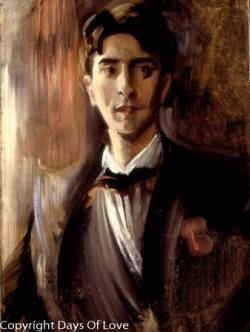 Jean
Maurice Eugène Clément Cocteau (5 July 1889 – 11 October 1963) was a French
poet, writer, designer, playwright, artist and filmmaker. Cocteau is best
known for his novel Les Enfants Terribles (1929), and the films The
Blood of a Poet (1930), Les Parents Terribles (1948), Beauty and
the Beast (1946) and Orpheus (1949). His circle of associates,
friends included
Kenneth Anger, Pablo Picasso, Joan Miró, Salvador Dalí,
Gertrude Stein,
Jean Hugo, Jean Marais,
Henri Bernstein, Yul Brynner,
Marlene Dietrich,
Coco Chanel, Erik Satie,
Albert Gleizes, Igor
Stravinsky, Marie
Laurencin, María Félix,
Édith Piaf,
Panama Al Brown,
Colette,
Jean Genet, and
Raymond Radiguet.
Jean
Maurice Eugène Clément Cocteau (5 July 1889 – 11 October 1963) was a French
poet, writer, designer, playwright, artist and filmmaker. Cocteau is best
known for his novel Les Enfants Terribles (1929), and the films The
Blood of a Poet (1930), Les Parents Terribles (1948), Beauty and
the Beast (1946) and Orpheus (1949). His circle of associates,
friends included
Kenneth Anger, Pablo Picasso, Joan Miró, Salvador Dalí,
Gertrude Stein,
Jean Hugo, Jean Marais,
Henri Bernstein, Yul Brynner,
Marlene Dietrich,
Coco Chanel, Erik Satie,
Albert Gleizes, Igor
Stravinsky, Marie
Laurencin, María Félix,
Édith Piaf,
Panama Al Brown,
Colette,
Jean Genet, and
Raymond Radiguet.
Jean Cocteau made a dramatisation of Le Portrait surnaturel de Dorian Gray in 1908.
While studying in Paris, Paul Thévanaz came under the influence of Igor Stravinsky and Jean Cocteau, and his paintings and murals reflect a fluidity of line and delight in color which leap out even from faded reproductions. In March 1914, Cocteau joined Stravinsky at the Grand Hotel in Leysin, accompanied by his then lover, Thévenaz, whom Cocteau introduced as an "unpolished, simple, fresh intelligence." Cocteau and Thévenaz had met at the School for Eurhythmy (École de Rythmique) on the Rue de Vaugirard, Paris, which taught the Dalcroze method, a discipline for "Norwegian artists" that joined athletics, vegeterianism, and dance. Paulet Thévanaz was the most talented student at the school; he had followed the teaching of Dalcroze, in Hellerau, near Dresden, as Nijinsky had done in 1912, and believed in the body as an instrument in itself, the equal of the violin or the piano, but one that had to be "played" independently of any music. Dazzled by the rhythmic movements that Thévenaz executed in the garden of Count Etienne de Beaumont's mansion on rue Duroc (Thévenaz gave the count, a ballet lover, gymnastic lessons in a black leotard), and charmed by his chamois-like suppleness, Cocteau decided to give him the role in David, which he already knew Nijinsky couldn't take. Thévanaz left for the United States with Jacques Copeau's dance group and never came back, suddenlty dying in 1921.
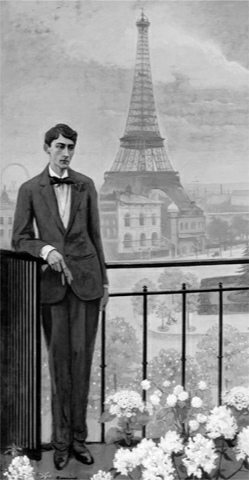
Jean Cocteau, portrayed by Romaine
Brooks as a totem of Parisian modernity,
1912.
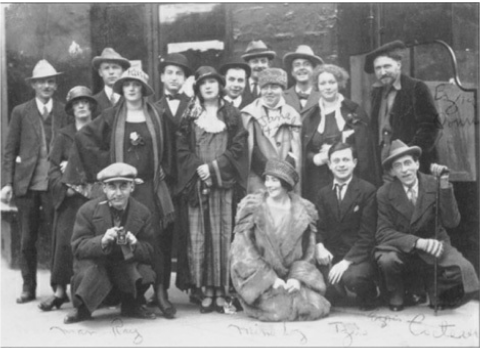
Margaret Anderson and Jane Heap, middle standing; Ezra Pound, right
standing; Man Ray, with camera; Mina Loy, front center; Tristan Tzara, to her
right; and Jean Cocteau, with cane; in Paris
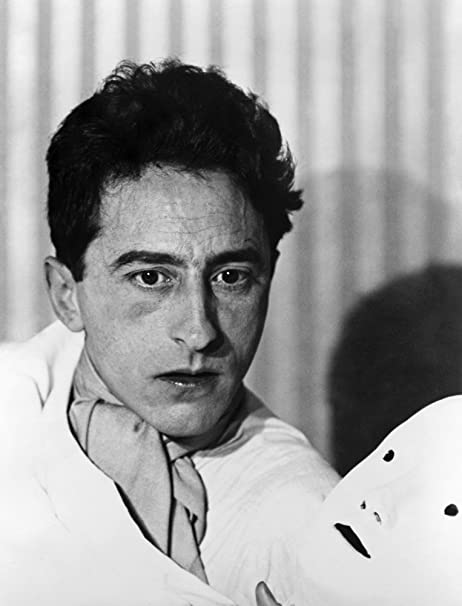
Jean Cocteau by Berenice Abbott
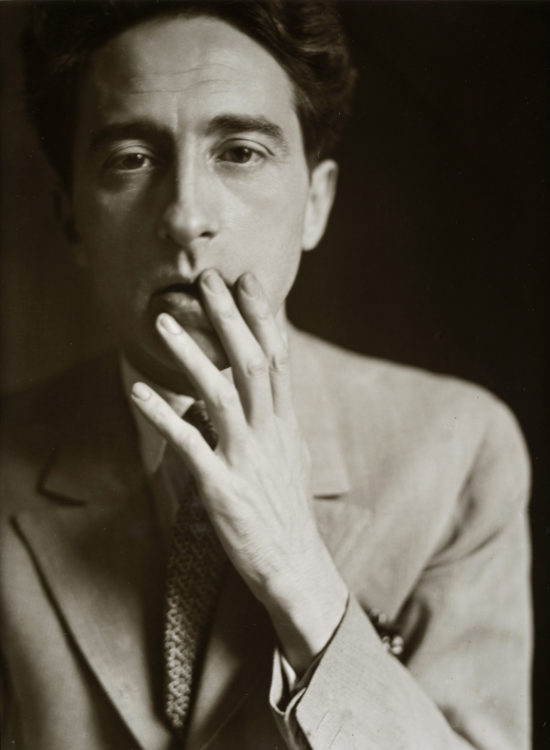
Jean Cocteau by Germaine Krull, 1929

Jean Cocteau, by Paul Thévenaz
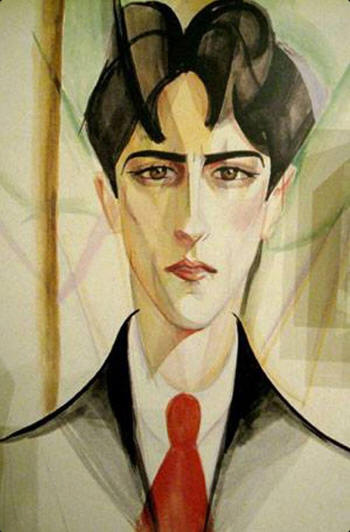
Jean Cocteau, 1917, by Paul Thévenaz
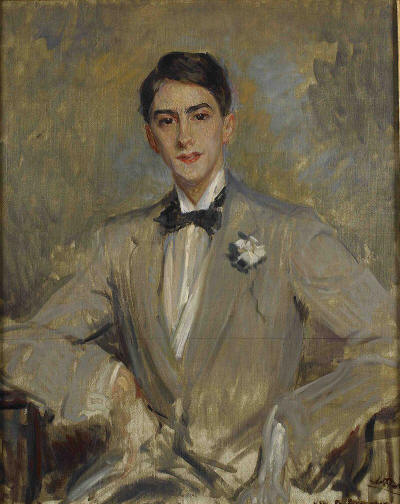
Jean Cocteau by Jacques-Émile Blanche
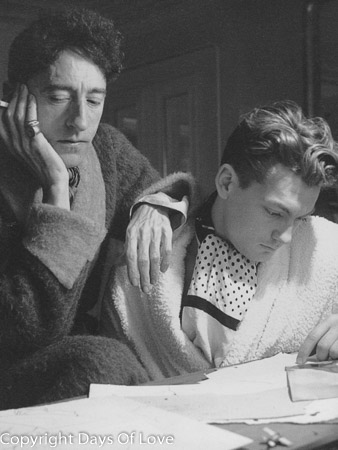
Jean Cocteau and Jean Marais
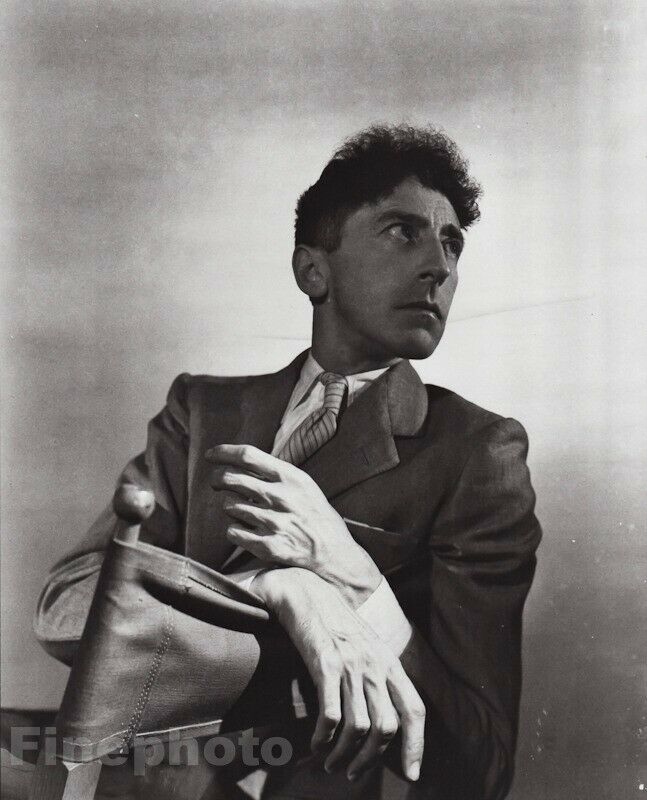
by George
Platt Lynes
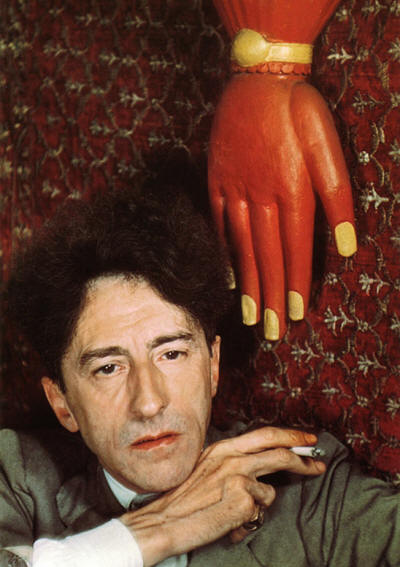
Jean Cocteau, 1939, by Gisèle Freund
A close friendship developed between Rolf de Maré and Jean Cocteau; and on 18 June 1921 the company performed Les Mariés de la Tour Eiffel, the ballet that had resulted from a collaboration between Cocteau and the radical group of Modernist composers, Les Six. On one evening, Jean Börlin danced, on points, the role of the Bathing Girl without anyone noticing that this masked dancer was actually a man.
In Paris in 1926 Medley met a dancer, Rupert Doone, with whom he lived for the rest of Doone's life. Like many other English visitors, the artist Robert Medley found the atmosphere of Paris distinctly relaxed: “There were no parents to worry about, and under French law nobody had the right to interfere with our relationship.” When he and his new lover, the dancer Rupert Doone, went there in May 1926, Medley found that Doone was already well known. He had been a lover of Jean Cocteau’s, a status with which limelight came as a compulsory extra (the affair had ended in 1924).
Back in Paris again in the spring of 1926, Klaus Mann met René Crevel, a committed internationalist for perverse reasons: "He spent his days with Americans, Germans, Russians, and Chinese, because his mother suspected all foreigners to be crooks or perverts". Sitting on Mann’s bed, Crevel read out the early chapters of his novel La Mort difficile, with their "venomous" portrait of his mother. On this trip, Mann also met Jean Cocteau ("The hours spent in his company assume in my recollection a savour both of burlesque show and magic ritual"), Eugene McCown, Pavel Tchelitchew, Julien Green, Jean Giraudoux and others.
Jean Cocteau never hid his homosexuality. He was the author of the mildly homoerotic and semi-autobiographical Le livre blanc (translated as The White Paper or The White Book),[10] published anonymously in 1928. He never repudiated its authorship and a later edition of the novel features his foreword and drawings. «As far back as I can remember, and even at a age when the mind does not yet influence the senses, I find traces of my love of boys. I have always loved the strong sex that I find legitimate to call the fair sex. My misfortunes came from a society that condemns the rare as a crime and forces us to reform our inclinations», the novel begins.
Frequently his work, either literary (Les enfants terribles), graphic (erotic drawings, book illustration, paintings) or cinematographic (The Blood of a Poet, Orpheus, Beauty and the Beast), is pervaded with homosexual undertones, homoerotic imagery/symbolism or outright camp. In 1947 Paul Morihien published a clandestine edition of Querelle de Brest by Jean Genet, featuring 29 very explicit erotic drawings by Cocteau. In recent years several albums of Cocteau's homoerotica have been available to the general public.
Cocteau had affairs with Jean Le Roy, Raymond Radiguet, Jean Desbordes, Marcel Khill, Panama Al Brown, among others.
In the 1930s, Cocteau is rumoured to have had a very brief affair with Princess Natalie Paley, the daughter of a Romanov Grand Duke and herself a sometime actress, model, and former wife of couturier Lucien Lelong.[11]
Janet Flanner's review of the 1932 American Women’s Show reminded that a number of talented American artists were then active: “The work of Lillian Cotton, Gwen Le Gallienne, Janet Scudder, Ivy Troutman, and Lillian Fisk, among others, showed an amazonian quality of strength that did not surprise or fail to please. As a group, theirs was by all odds the best amalgamated work of the year”. This same letter included an assessment of work by Salvador Dali, Jean Cocteau (ink drawings), and Francis Rose, the newly discovered protégé of Gertrude Stein.
Cocteau's longest-lasting relationships were with French actors Jean Marais[12] and Édouard Dermit, whom Cocteau formally adopted. Cocteau cast Marais in The Eternal Return (1943), Beauty and the Beast (1946), Ruy Blas (1947), and Orpheus (1949).
During the post-WWII period, the French theatre was dominated by Jean Cocteau's circle, including the stage designer Christian Bérard and the actor Jean Marais; the bisexual Gérard Philipe was everyone's favorite leading man. The foremost members of the Comedic Francaise, such as Jean Weber and Jacques Charon, were familiar faces at gay salons. Julien Green's monumental Sud (South, 1953) clothed his doomed love story in Civil War garb and veiled suggestion; the agony of unrequited affection went even deeper in Henry de Montherlant's La Ville dont le Prince en un Enfant (The City Whose Prince Is a Child, 1951), set in a Catholic school where an obsessive priest roots out the special friendships of the students. Typically, the secretive and suicidal Montherlant considered it unsuitable for public performance by boys.
Cocteau died of a heart attack at his chateau in Milly-la-Forêt, Essonne, France, on 11 October 1963 at the age of 74. His friend, French singer Édith Piaf, died the day before but that was announced on the morning of Cocteau's day of death; it has been said that his heart failed upon hearing of Piaf's death. Actually, according to author Roger Peyrefitte, Cocteau was devastated after a breach with his longtime friend and patronness Francine Weisweiller.
According to his wishes Cocteau is buried beneath the floor of the Chapelle Saint-Blaise des Simples in Milly-la-Forêt.[13] The epitaph on his gravestone set in the floor of the chapel reads: "I stay with you" ("Je reste avec vous").
My published books: